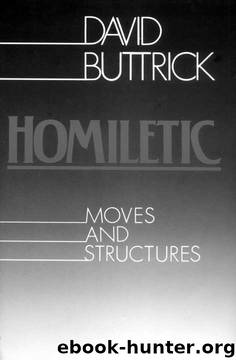Homiletic Moves and Structures by David Buttrick

Author:David Buttrick
Language: eng
Format: epub
Published: 2008-07-14T09:00:00+00:00
A DOUBLE HERMENEUTIC
As mediation, preaching dabbles in what might be termed a twofold act of interpretation, a double hermeneutic. We are often told that preachers must be bifocal; that they should read the Bible with one eye and daily papers with the other. The shibboleth, usually attributed to Barth, is helpful for at least it sets preachers free to read newspapers without undue guilt, but otherwise is less than adequate. The bifocal hermeneutic of preaching is somewhat more complex. What do we mean by a double hermeneutic?
Preachers explore the Mystery of God through Jesus Christ; they are concerned with what is usually regarded as "revelation." Because preaching is "through Jesus Christ," preachers will turn to texts, notably to the texts of scripture. In Christian scriptures, we stumble on written recollections of apostolic preaching which, by proximity to the Christ-event, have certain primacy for us. (Early Christian literature, sometimes labeled noncanonical, can provide a significant context for the interpretation of scripture.) Yet in the New Testament, we become acquainted with Christ Jesus, storied human being and Living Symbol, and may even find ourselves drawn into a historybridging "communion" with Christ. Of course, we cannot fully comprehend Jesus Christ without turning to the Hebrew scriptures. They give us Christ's own "world-in-consciousness" as well as the mind which interpreted Christ, a mind that already knew of God-with-us bracketed by myths of origin and visions of consummation. In interpreting scripture, we will be guided by churchly tradition; liturgies which may embody the church's earliest recitals of faith, creeds which down through the centuries have crystallized the church's grasp of revelation, and contemporary theology which in every age ponders anew the Mystery of God through Jesus Christ. In sum, to explore Jesus Christ, preachers will inevitably turn to a study of texts.
As we study Christ, we will discover that "revelation" seems to form in consciousness in somewhat different ways. Christ clearly comes to us as a character in Israel's religious story, a God-with-us story, but also as a living symbol who, standing before the Mystery, mediates the "interior" of God, that is, God's intending toward us. Certainly we read in scripture stories of Jesus, where he was born, what he said and did, and how he died. Thus, we read tales about a particular human being in a human world under God. But also in scripture we bump into odd christological titles-"Lord," "Savior," "Son of God," and the like-as well as acclamations of faith, liturgical creeds, and profound testimonies of who Christ was for an early-day being-saved Christian community. In scripture, Jesus Christ does come to us as "story" and "symbol," as human and divine. Of course, we can spot the same odd structure in Christian art. In some churches, we will see pictures of Bible stories, including episodes from the life of Christ such as the Stations of the Cross, but also images of Christ that seem to be functioning symbolically, such as a hoisted-up empty cross or an enthroned cloudy Lord, not to mention particular symbols associated with Christ-the Rock, the Lamb, the Vine, and so on.
Download
This site does not store any files on its server. We only index and link to content provided by other sites. Please contact the content providers to delete copyright contents if any and email us, we'll remove relevant links or contents immediately.
| Adult Ministry | Children's Ministry |
| Counseling & Recovery | Discipleship |
| Evangelism | Missions & Missionary Work |
| Preaching | Sermons |
| Youth Ministry |
Victory over the Darkness by Neil T. Anderson(2815)
The Rape Of Nanking by Iris Chang(2773)
Chosen by God by R. C. Sproul(2122)
Habits of Grace by David Mathis(1943)
Crash the Chatterbox by Steven Furtick(1939)
Knowing God by J.I. Packer(1804)
How To Be Born Again by Billy Graham(1730)
A Prophet with Honor by William C. Martin(1681)
Gospel-Shaped Marriage by Chad van Dixhoorn(1679)
Peace with God by Billy Graham(1642)
Confronting Christianity by Rebecca McLaughlin(1555)
God's Smuggler by Brother Andrew(1509)
Angel Dreams by Virtue Doreen Virtue Melissa(1447)
Whisper by Mark Batterson(1421)
Missionaries by Norman Lewis(1393)
The School of Biblical Evangelism by Ray Comfort(1389)
The Truth War by John MacArthur(1387)
The Poems of Rowan Williams by Rowan Williams(1320)
Do Greater Things by Robby Dawkins(1291)
